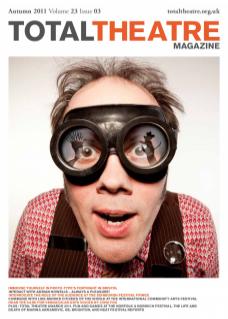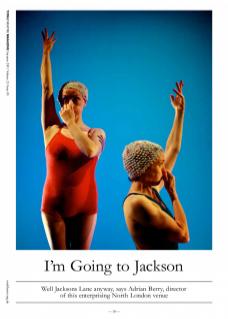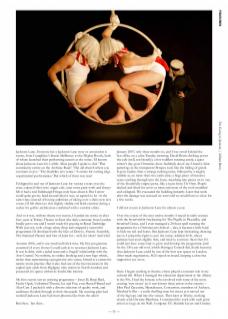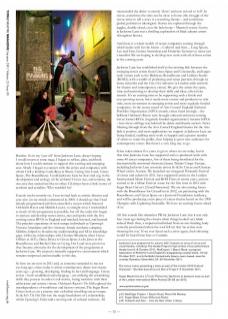Jacksons Lane. Everyone has a Jacksons Lane story or association it seems, from Complicite’s Simon McBurney to the Mighty Boosh, both of whom launched their performing careers at the venue. I’d known about Jacksons Lane for a while. Most people I spoke to did. ‘That community centre on the Archway Road.’ ‘The old church where you can learn to jive.’ ‘The disability arts venue.’ ‘A centre for cutting edge experimental performance.’ But which of these was true?
I’d dipped in and out of Jacksons Lane for various events over the years, enjoyed their tasty veggie cafe, seen some great work and always felt it had a real Edinburgh Fringe-style buzz about it. But I never could quite get my head around what it was, or aspired to be. At the same time, instead of having ambitions of taking over a shiny new arts venue, I’d felt drawn to this slightly shabby red brick creation (being a sucker for gothic architecture combined with a socialist ethic).
And so it was, without rhyme nor reason, I handed my notice in after four years at Trinity Theatre in Kent (the daily commute from London finally got to me and I wasn’t ready for grazing in Royal Tunbridge Wells just yet), took a huge salary drop and swapped a successful programme I’d developed with the likes of Derevo, Frantic Assembly, The National Theatre and Out of Joint for... well, for what? And why?
Autumn 2006, and it was mud/wall/stick time. My first programme consisted of every favour I could cash in to resurrect Jacksons Lane. It was in debt, with a jaded team and a ‘fragile’ relationship with the Arts Council. No website, no online booking and a new logo which, rather than representing a progressive arts venue, hinted at a centre for tantric erotic practice. But it also had one of the best locations in the capital (just yards from Highgate tube station in North London) and possessed six spaces within its Tardis-like interior.
My first season saw an enticing programme – Jonzi D, Benji Reid, Faulty Optic, Unlimited Theatre, Ice and Fire, even Russell Brand and Alan Carr. I packed it with a diverse selection of quality work, and audiences flooded through in their thousands. My cunning plan had worked! Jacksons Lane had risen phoenix-like from the ashes!
But then... but then...
January 2007, only three months in, and I was stood behind the box office on a calm Tuesday morning. David Bowie drifting across the cafe (well, not literally); a few toddlers running amok; a quiet winter’s day, post Christmas show. Suddenly above me I heard a faint pattering on the transparent Perspex roof, like the falling of gravel. It grew louder, then a strange rushing noise, followed by a mighty rumble as, no more than two yards away, a huge piece of masonry came crashing through into the foyer, smashing into pieces on to one of the (thankfully empty) pews, like a scene from The Omen. People ducked and dived for cover as more and more of the roof crumbled and collapsed. We evacuated the building instantly. Later that week after the damage was assessed we were told we would have to close for a few weeks.
I did not return to Jacksons Lane for almost a year.
Over the course of the next twelve months I stayed in radio contact with the board whilst freelancing for The Pigalle in Piccadilly, and Stratford Circus, and I even managed a 24-hour spell running the programme for a Christian arts festival – alas, it became a little hard to hide my tail and horns. But Jacksons Lane kept beckoning, drawing me in. I joined the fight to save the venue, lobbied ACE, whose patience had worn slightly thin, and tried to convince them that if I could just have some time to grow and develop the programme (and fix the 130-year-old roof, which Haringey Council did, thank heavens) then Jacksons Lane could be one of the best arts spaces in London. After much negotiation, ACE stayed on board, keeping a close but supportive eye on us.
Since I began working in theatre, circus played a constant role in my cultural life. When I managed the education department at the Albany in the 90s, I had the fortune to be involved with some of the most exciting ‘new circus’ (as it was known then) artists in the country – John Paul Zaccarini, Mamaloucos, Concussion, members of Archaos, Mischief le Bas – a really thrilling time for circus as it moved out of the big tops and into the venues. Then later at Trinity, working closely with Chenine Bhathena, I continued the work with such great artists as Legs on the Wall, Company FZ, Matilda Leyser and Lindsey Butcher. So in my ‘year off’ from Jacksons Lane, always hoping I would return at some stage, I began to reflect, plan, and think about how I could continue to support this exciting and emerging area. Slowly I began to connect with the artists and companies with whom I felt a kinship: Layla Rosa at Shunt, Crying Out Loud, Circus Space, The Roundhouse. Could Jacksons Lane be that vital cog in the development and ecology of the artform? Circus was, and remains, the one area that excited me like no other. I’d always been a little in awe of acrobats and aerialists. Who wouldn’t be?
Exactly twelve months on, I was invited back as artistic director and year zero (in my mind) commenced in 2008. I should say that I had already programmed and then cancelled a season which featured Ockham’s Razor and Matilda Leyser, so straight away I rescheduled as much of this programme as possible, but off the radar also began to nurture and develop newer artists, met and spoke with the five existing circus RFOs in England and watched, listened, and learned. The priceless experience of such unique individuals as Upswing’s Victoria Amedume and the visionary female acrobatic company, Mimbre, helped to broaden my understanding and fill in knowledge gaps, whilst my relationships with Chenine Bhathena (then Circus Officer at ACE), Daisy Drury at Circus Space, Leila Jones at the Roundhouse and Rachel Clare at Crying Out Loud were pivotal as they became advocates for the development of the programme at Jacksons Lane. We created a mutually supportive environment which remains reciprocal and invaluable to this day.
So here we are now in 2011 and, as someone remarked to me not too long ago, circus today is where contemporary dance was twenty years ago – growing, developing, finding its feet and language. Circus artists – both established and emerging – are utilising the astonishing skills they possess in order to tell stories, fusing narrative with their athleticism and artistic visions. Ockham’s Razor’s The Mill explored the interdependency of workforces and factory systems; The Sugar Beast Circus took us on a journey into an Indian travelling circus troupe; So & So’s The Hot Dots saw the tragic breakdown of a relationship; whilst Upswing’s Fallen told a moving tale of cultural isolation. All transcended the desire to merely ‘show’ and now strived to ‘tell’. In circus, sometimes the tales can be close to home (the struggle of the circus artist to tell a story is a recurring theme) – and sometimes global, political or ideological. Stories are explored through the juggler, double cloud, even the hula-hoop – Marawa’s recent Exotica at Jacksons Lane was a thrilling exploration of black cabaret artists throughout history.
And there is a whole wealth of newer companies coming through which bodes well for the future – Collectif and then..., Long Spoon, Leo and Yam, Genius Sweatshop and Frederike Gerstner to name just a handful. We are hoping to develop new work with all of these artists in the coming years.
Jacksons Lane has established itself as the missing link between the emerging circus artists from Circus Space and Circomedia, and larger scale venues such as the Barbican, Roundhouse and Linbury Studio (ROH2), with a wealth of producing and venue partners through its many networks and the City Circ initiative (a London-wide network for theatre and contemporary circus). We give the artists the space, time and mentoring to develop their skills and ideas, often from scratch. It’s an exciting time to be supporting such a fertile and ever-growing sector, but it needs more venues and producers to take risks, more investment in emerging artists and more regularly funded companies. In the recent round of Arts Council England National Portfolio Organisation (NPO) awards, circus fared strongly – the brilliant Ockham’s Razor were brought onboard and most existing circus former RFOs (‘regularly funded organisations’) became NPOs – but circus still lags way behind the dance and theatre sectors. News filtering through from the Arts Council England Grants for the Arts bids is positive, and most applications we support at Jacksons Lane are being funded, enabling more work to happen and a greater number of artists to reach the public, thus helping to grow new audiences for contemporary circus. But there’s a very long way to go.
It has taken almost five years to get to where we are today, but in that time Jacksons Lane has supported and co-produced work with some 40 circus companies, five of them being shortlisted for the internationally renowned showcase Jeunes Talents Cirque Europe, including Jacksons Lane associate artists So & So Circus and German Wheel artists Acrojou. We launched our inaugural Postcards Festival of circus and cabaret in 2011, have supported artists in the London International Mime Festival and ROH Firsts in recent years, and are excited to be a Mime Festival venue for the first time in 2012 with Sugar Beast Circus’s {Event(Dimension):}. We are also joining forces with the Roundhouse for CircusFest in 2012, are partnering with the Roundhouse and Circus Space on a Jerwood Foundation residency, and will be producing a new piece of circus-theatre based on the 1908 Olympics with Lightning Ensemble. We have an exciting future ahead of us.
All this sounds like shameless PR for Jacksons Lane, but it was only four years ago during the closure when things looked very bleak indeed. Back then, a respected individual from an arts funding body correctly proclaimed (when the roof fell in) that ‘no artists were shouting for you’. If we ever faced such a crisis again, their shouting would be heard from here to Camden.
Jacksons Lane programme for autumn 2011 features an array of circus and visual theatre, including: The Awake Project’s high octane circus performance Awake from 6–8 October 2011; RedCape’s 1 Beach Road, a poignant exploration of Alzheimer’s and England’s disappearing coastal towns, 19–22 October 2011; and Little Bulb’s fantastically bizarre music-based, anarchic comedy Operation Greenfield, 23–24 November 2011.
The venue is also presenting a show as part of the London 2012 Cultural Olympiad – Stumble danceCircus’s Box of Frogs 4–5 November 2011.
Sugar Beast Circus’s {Event(Dimension):}performs at Jacksons Lane as part of the London International Mime Festival 26–28 Jan 2012.



